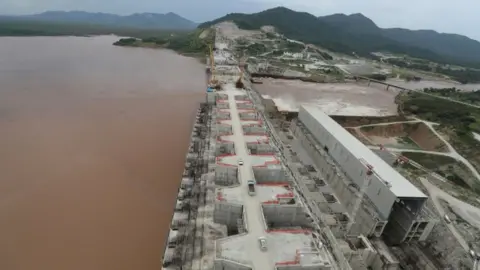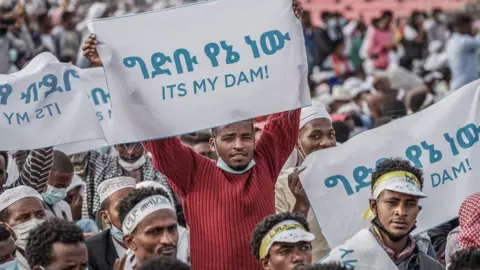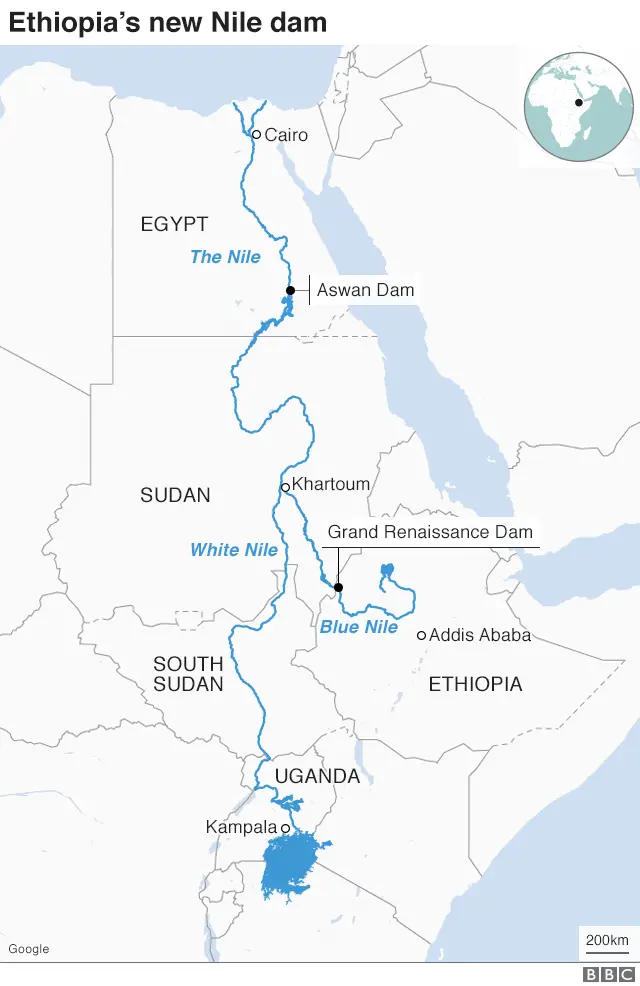River Nile dam: Why Ethiopia can't stop it being filled
 Reuters
ReutersThe long-running dispute between Egypt, Sudan and Ethiopia over a massive hydroelectric dam being built on the River Nile shows no sign of being resolved. On Thursday, the UN Security Council is due to discuss it for the first time, as some fear it could lead to conflict.
Egypt and Sudan have both complained that Ethiopia has acted unilaterally for a second year and begun to fill up the reservoir behind the Grand Ethiopian Renaissance Dam (Gerd).
Egypt, which relies almost entirely on the Nile for its water supply, sees this as an existential issue. Last year, Sudan's water supply was disrupted by the filling of the dam, while Ethiopia sees it as a way to bring electricity to millions of its citizens.

In a statement earlier this week Egypt and Sudan accused Ethiopia of acting unilaterally over the filling and having "bad intentions" - suggesting the dam was being filled deliberately.
But this gives the false impression that filling up the dam is like filling up a bath - and that Ethiopia can turn a tap on and off at will.
Can't it be stopped?
No. The reservoir behind the dam will fill naturally during the Blue Nile's rainy season, which has already begun and lasts until September.
Given the stage that the construction is at, "engineering-wise, physics-wise there is no way to stop the filling now" until the water level reaches the top of the dam wall, Manchester University's Mohammed Basheer, who has been studying the Gerd for the past decade, told the BBC.
This is because more water is entering the dam site than the volume of water that can physically pass through the two open outlets in the dam wall (60-110 million cubic metres a day).

Explore the Nile with 360 video
Alastair Leithead and his team travelled in 2018 from the Blue Nile's source to the sea - through Ethiopia and Sudan into Egypt.

From the start of the process in 2011, the dam has been built around the Blue Nile as it continued to flow through the enormous building site.
Builders worked on the vast structures on either side of the river without any problem. In the middle, during the dry season, the river was diverted through culverts, or pipes, to allow that section to be built up.
Much of the middle section is now complete and each year more will be added until about 2024 when it will be at 640m above sea level. The river bed at the dam site is around 509m above sea level.
What's the next stage?
In the first year, the Gerd retained 4 billion cubic metres (bcm) of water, taking it up to the height of the lowest point on the dam wall at that time.
On average, the total annual flow of the Blue Nile at the Gerd site is 49bcm, but last year saw a 100-year record for the peak daily flow of water, indicating that only a small fraction of that annual water volume was held back.
Although the dam engineering means the reservoir would have filled up last year anyway, Ethiopia sped up the process by closing three of the four diversion outlets at the bottom of the dam wall, Mr Basheer says.
 AFP
AFPThis year the initial idea was to add a further 13.5bcm but satellite images analysed recently by Sudan suggest that the dam wall has not been built as high as first planned, which would mean more water would pass through.
However, a note from Ethiopia's water ministry to Sudan sent earlier this week indicated that the dam was still on course for holding back the same amount as originally planned.
In the dry season the reservoir will recede a bit, allowing for the dam wall to be built up and in the third year more water will be retained.

You may also be interested in:

Ethiopia says it will take a further four to six years to fill up the reservoir to its maximum flood season capacity of 74bcm. At that point, the lake that will be created could stretch back some 250km (155 miles) upstream.
Between each subsequent flood season the reservoir will be lowered to 49.3bcm.
Why is Egypt unhappy?
Egypt sees the Gerd as having the potential to threaten its very existence. Its near-total reliance on the Nile for water means it is very nervous about what could happen upstream.
Egypt wants a guarantee of a certain volume of water.
During the filling process, Egypt can compensate for a loss of water by releasing more from the High Aswan Dam, but the concern comes once the Gerd is fully operational.
 Reuters
ReutersWhen the filling stage is over, Ethiopia is reluctant to be tied to a figure of how much water to release. Its priority will be to make sure there is enough water to operate what will become the largest hydroelectric plant in Africa.
In years of normal, or above average, rainfall that should not be a problem, but Egypt is nervous about what might happen during a prolonged drought that could last several years.
In that case, if Ethiopia holds back water in the Gerd then the levels in the High Aswan Dam will start to fall.
And there is also a question over the refilling schedules of the other dams on the Nile following a drought.
What about Sudan?
In the past 12 months Sudan's rhetoric about the dam has moved from being broadly welcoming to being suspicious and belligerent.
Mr Basheer thinks it can be traced back to last year's filling of the dam.
The Gerd, in theory, could help regulate the flow of the Blue Nile and make Sudan less prone to floods.
But last year, Sudan was taken by surprise when Ethiopia shut three of the four diversion outlets for the water.
This led to lower levels downstream which disrupted Sudan's pumping stations for irrigation and municipal water supply.


